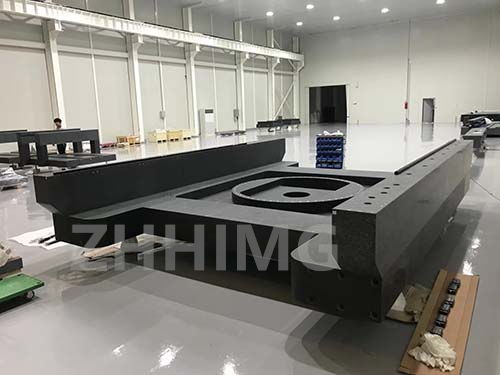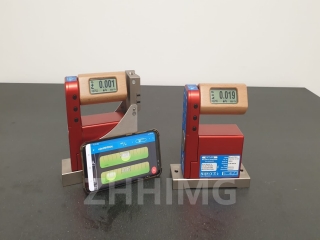In the precise and complex semiconductor manufacturing process of wafer packaging, thermal stress is like a "destroyer" hidden in the dark, constantly threatening the quality of packaging and the performance of chips. From the difference in thermal expansion coefficients between chips and packaging materials to the drastic temperature changes during the packaging process, the generation pathways of thermal stress are diverse, but all point to the result of reducing the yield rate and affecting the long-term reliability of chips. The granite base, with its unique material properties, is quietly becoming a powerful "assistant" in dealing with the problem of thermal stress.
The thermal stress dilemma in wafer packaging
Wafer packaging involves the collaborative work of numerous materials. Chips are typically composed of semiconductor materials such as silicon, while packaging materials like plastic packaging materials and substrates vary in quality. When the temperature changes during the packaging process, different materials vary greatly in the degree of thermal expansion and contraction due to significant differences in the coefficient of thermal expansion (CTE). For instance, the coefficient of thermal expansion of silicon chips is approximately 2.6×10⁻⁶/℃, while the coefficient of thermal expansion of common epoxy resin molding materials is as high as 15-20 ×10⁻⁶/℃. This huge gap causes the shrinkage degree of the chip and the packaging material to be asynchronous during the cooling stage after packaging, generating a strong thermal stress at the interface between the two. Under the continuous effect of thermal stress, the wafer may warp and deform. In severe cases, it may even cause fatal defects such as chip cracks, solder joint fractures, and interface delamination, resulting in damage to the electrical performance of the chip and a significant reduction in its service life. According to industry statistics, the defective rate of wafer packaging caused by thermal stress issues can be as high as 10% to 15%, becoming a key factor restricting the efficient and high-quality development of the semiconductor industry.

The characteristic advantages of granite bases
Low coefficient of thermal expansion: Granite is mainly composed of mineral crystals such as quartz and feldspar, and its coefficient of thermal expansion is extremely low, generally ranging from 0.6 to 5×10⁻⁶/℃, which is closer to that of silicon chips. This characteristic enables that during the operation of wafer packaging equipment, even when encountering temperature fluctuations, the difference in thermal expansion between the granite base and the chip and packaging materials is significantly reduced. For instance, when the temperature changes by 10℃, the size variation of the packaging platform built on the granite base can be reduced by more than 80% compared with the traditional metal base, which greatly alleviates the thermal stress caused by the asynchronous thermal expansion and contraction, and provides a more stable support environment for the wafer.
Excellent thermal stability: Granite has outstanding thermal stability. Its internal structure is dense, and the crystals are closely bonded through ionic and covalent bonds, allowing for slow heat conduction within. When the packaging equipment undergoes complex temperature cycles, the granite base can effectively suppress the influence of temperature changes on itself and maintain a stable temperature field. Relevant experiments show that under the common temperature change rate of packaging equipment (such as ±5℃ per minute), the surface temperature uniformity deviation of the granite base can be controlled within ±0.1℃, avoiding the phenomenon of thermal stress concentration caused by local temperature differences, ensuring that the wafer is in a uniform and stable thermal environment throughout the packaging process, and reducing the source of thermal stress generation.
High rigidity and vibration damping: During the operation of wafer packaging equipment, the mechanical moving parts inside (such as motors, transmission devices, etc.) will generate vibrations. If these vibrations are transmitted to the wafer, they will intensify the damage caused by thermal stress to the wafer. Granite bases have high rigidity and a hardness higher than that of many metal materials, which can effectively resist the interference of external vibrations. Meanwhile, its unique internal structure endows it with excellent vibration damping performance and enables it to dissipate vibration energy rapidly. Research data shows that the granite base can reduce the high-frequency vibration (100-1000Hz) generated by the operation of packaging equipment by 60% to 80%, significantly reducing the coupling effect of vibration and thermal stress, and further ensuring the high precision and high reliability of wafer packaging.
Practical application effect
In the wafer packaging production line of a well-known semiconductor manufacturing enterprise, after introducing packaging equipment with granite bases, remarkable achievements have been made. Based on the analysis of the inspection data of 10,000 wafers after packaging, before adopting the granite base, the defect rate of wafer warping caused by thermal stress was 12%. However, after switching to the granite base, the defect rate dropped sharply to within 3%, and the yield rate significantly improved. Furthermore, long-term reliability tests have shown that after 1,000 cycles of high temperature (125℃) and low temperature (-55℃), the number of solder joint failures of the chip based on the granite base package has been reduced by 70% compared with the traditional base package, and the performance stability of the chip has been greatly improved.
As semiconductor technology continues to advance towards higher precision and smaller size, the requirements for thermal stress control in wafer packaging are becoming increasingly strict. Granite bases, with their comprehensive advantages in low thermal expansion coefficient, thermal stability and vibration reduction, have become a key choice for improving the quality of wafer packaging and reducing the impact of thermal stress. They are playing an increasingly important role in ensuring the sustainable development of the semiconductor industry.
Post time: May-15-2025

